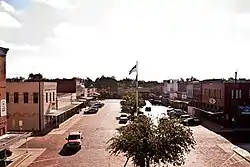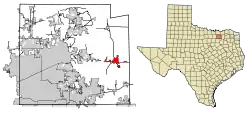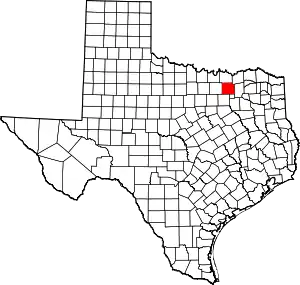Farmersville, Texas
Farmersville is a city primarily located in Collin County, Texas, United States, but a small portion is in Hunt County. The population was 3,612 at the 2020 census.[5]
Farmersville, Texas | |
|---|---|
 Farmersville Commercial District | |
| Motto: "Discover a Texas Treasure"[1] | |
 Location of Farmersville in Collin County, Texas | |
| Coordinates: 33°9′51″N 96°22′0″W | |
| Country | United States |
| State | Texas |
| County | Collin |
| Government | |
| • Mayor | Bryon Wiebold |
| Area | |
| • Total | 4.27 sq mi (11.07 km2) |
| • Land | 4.11 sq mi (10.63 km2) |
| • Water | 0.17 sq mi (0.43 km2) |
| Elevation | 653 ft (199 m) |
| Population (2020) | |
| • Total | 3,612 |
| • Density | 884.29/sq mi (341.39/km2) |
| Time zone | UTC-6 (Central (CST)) |
| • Summer (DST) | UTC-5 (CDT) |
| ZIP code | 75442 |
| Area code | 972 |
| FIPS code | 48-25488[3] |
| GNIS feature ID | 1335715[4] |
| Website | www |
History
| Census | Pop. | Note | %± |
|---|---|---|---|
| 1870 | 114 | — | |
| 1880 | 230 | 101.8% | |
| 1890 | 1,093 | 375.2% | |
| 1900 | 1,856 | 69.8% | |
| 1910 | 1,848 | −0.4% | |
| 1920 | 2,167 | 17.3% | |
| 1930 | 1,878 | −13.3% | |
| 1940 | 2,206 | 17.5% | |
| 1950 | 1,955 | −11.4% | |
| 1960 | 2,021 | 3.4% | |
| 1970 | 2,311 | 14.3% | |
| 1980 | 2,360 | 2.1% | |
| 1990 | 2,640 | 11.9% | |
| 2000 | 3,118 | 18.1% | |
| 2010 | 3,301 | 5.9% | |
| 2020 | 3,612 | 9.4% | |
| U.S. Decennial Census[6] | |||
Farmersville originated in 1849 as a settlement on the Jefferson-McKinney Road, and near Republic of Texas National Road. The settlement was named by pioneers William Pickney Chapman & John Hendrex for their chief occupation.[7]
After 1854, the Yearys and their neighbors of Sugar Hill (2 miles northeast) began relocating here. H.M. Markham, practicing here by 1855, is said to have been Collin County's earliest physician. The first Methodist Church was organized in 1856. William Gotcher on March 4, 1859, donated land for the public square. A school was operating as early as the 1860s. The first Baptist Church was organized on May 14, 1865.[1]
The town was incorporated on June 2, 1873. The first mayor was John S. Rike. The first aldermen were James Church, Ben King, John Murchison, Tom Tatum, and John P. Utt. The first Marshal was Jeff Hines.
Institutions from the 1880s that are still in operation include the Farmersville Times, the oldest newspaper in Collin County,[8] and the First Bank, as well as the two churches mentioned above.
On June 15, 1945, Audie Murphy, the most decorated soldier of World War II, came home to a hero's welcome in Farmersville. Thousand's filled the square to listen to a speech given by him, and the event was noted in the July 16, 1945 edition of Life Magazine. A Texas Historical Commission plaque notes the event on the square.[9]
As the town became a trade center, agriculture kept pace. Farmersville in the 1930s was known as the "Onion Capital of North Texas", annually shipping over 1,000 carloads of onions. Along with some small industry, cattle, cotton, and maize crops remain important.[10]
On May 8, 2021, in honor of Audie Murphy, the most decorated soldier of WWII, a "Sister City Pact" with Holtzwihr, France was signed.[11][12] This ceremony was to announce the common bond between the two cities and recognize Murphy's heroism at the Battle of Holtzwihr on January 26, 1945.
Geography
U.S. Route 380 crosses the south side of the city, leading west 18 miles (29 km) to McKinney and east 15 miles (24 km) to Greenville. Texas State Highway 78 passes through the west side of Farmersville, leading north 10 miles (16 km) to Blue Ridge and southwest 27 miles (43 km) to Garland. The north end of Lavon Lake is 4 miles (6 km) to the west.
According to the United States Census Bureau, Farmersville has a total area of 4.0 square miles (10.4 km2), of which 3.8 square miles (9.9 km2) is land and 0.2 square miles (0.4 km2), or 4.18%, is water.[13]
Climate
The climate in this area is characterized by hot, humid summers and generally mild to cool winters. According to the Köppen Climate Classification system, Farmersville has a humid subtropical climate, abbreviated "Cfa" on climate maps.[14]
Demographics
| Race | Number | Percentage |
|---|---|---|
| White (NH) | 2,123 | 58.78% |
| Black or African American (NH) | 235 | 6.51% |
| Native American or Alaska Native (NH) | 4 | 0.11% |
| Asian (NH) | 19 | 0.53% |
| Pacific Islander (NH) | 2 | 0.06% |
| Some Other Race (NH) | 11 | 0.3% |
| Mixed/Multi-Racial (NH) | 162 | 4.49% |
| Hispanic or Latino | 1,056 | 29.24% |
| Total | 3,612 |
As of the 2020 United States census, there were 3,612 people, 1,396 households, and 799 families residing in the city.[15]
Education
The city is served by the Farmersville Independent School District.[18] Collin College operates a branch campus in Farmersville.
Media
The Farmersville Times is a weekly newspaper published in the city. The newspaper was established in 1885, and is part of C&S Media Publications Inc.[8][19]
Notable people
- Stevie Benton, bassist for American heavy metal band Drowning Pool, resided in Farmersville and attended Farmersville High School
- Herb Ellis (1921–2010), jazz guitarist, born in Farmersville
- Monty "Hawkeye" Henson, three-time world champion rodeo cowboy, born in Farmersville
- John Monroe, was an infielder in Major League Baseball for the New York Giants and Philadelphia Phillies
- Loren Murchison, winner of two Olympic gold medals
- Audie Murphy, United States' most decorated combat soldier of World War II, spent his childhood in Kingston, Texas and surrounding areas
- Tex Watson, murderer and member of the Manson Family, best known for his involvement (with Susan Atkins) in the stabbing murders of Sharon Tate and her unborn child, grew up in Copeville and attended Farmersville Independent School District
Notes
References
- "City of Farmersville Texas". City of Farmersville Texas. Archived from the original on October 3, 2012. Retrieved October 19, 2012.
- "2019 U.S. Gazetteer Files". United States Census Bureau. Retrieved August 7, 2020.
- "U.S. Census website". United States Census Bureau. Retrieved January 31, 2008.
- "US Board on Geographic Names". United States Geological Survey. October 25, 2007. Retrieved January 31, 2008.
- "2020 Race and Population Totals". United States Census Bureau. Retrieved November 6, 2021.
- "Census of Population and Housing". Census.gov. Retrieved June 4, 2015.
- "Farmersville Historical Markers" (PDF). Farmersville Historical Markers. Retrieved May 20, 2016.
- "The Farmersville Times celebrates milestone 125th year". Texas Press Association. Archived from the original on August 4, 2014. Retrieved October 19, 2012.
- "Details of Audie Murphy's Homecoming". Texas Historical Commission. Retrieved August 19, 2018.
- "Small Town Treasures To Visit In The Texas Hill Country". Retrieved September 15, 2015.
- "Sister City Signing Ceremony". Facebook. Retrieved July 7, 2021.
- "City to adopt 'Sister City' program". Farmersville. Retrieved July 7, 2021.
- "Geographic Identifiers: 2010 Census Summary File 1 (G001): Farmersville city, Texas". U.S. Census Bureau, American Factfinder. Archived from the original on February 13, 2020. Retrieved July 30, 2015.
- Climate Summary for Farmersville, Texas
- "Explore Census Data". data.census.gov. Retrieved May 22, 2022.
- https://www.census.gov/
- "About the Hispanic Population and its Origin". www.census.gov. Retrieved May 18, 2022.
- "Farmersville Independent School District". Farmersville Independent School District. Retrieved October 19, 2012.
- "The Farmersville Times". The Farmersville Times. Archived from the original on June 18, 2012. Retrieved October 19, 2012.
